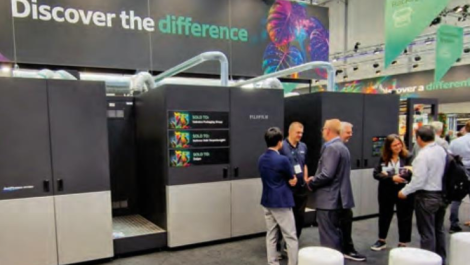Members of the Digital Labels & Packaging Industry Group gathered in March to discuss their views on the latest developments in the label and packaging industry, and also got the chance to grab a close up of the HP 20000 wide web digital press. Michal Lodej reports.
The roundtable event was hosted by one of the group’s newest members, Ultimate Digital, at its headquarters in Grimsby. In these modern inspiring facilities, members came together to talk about how they have seen the labels and packaging market develop since the last meeting.
The day began with a presentation from host Chris Tonge, who spoke about how the company has metamorphosed from one entity into three separate ones: Ultimate Packaging, Ultimate Digital and design agency Sharp Iris.
Its flexo operation, Ultimate Packaging, runs 24/7 and turns over £45 million a year. It is an area the company is still investing in, having recently purchased two Bobst F+K wide web flexo presses. However Mr Tonge believes there will come a time when no one will be investing in flexo. ‘At some stage digital will replace everything. It is a matter of when, not if, but the presses have got to go a lot faster before this happens. We present digital print as a different technology and use it for the benefits that it can bring to our customers.’
The company has not just transferred existing clients to digital but has also won new customers. One such is Walkers Crisps, which took advantage of the personalisation capabilities Ultimate offers with its SmartFlow solution. This linked social media to packaging by adding names and messages to packs of crisps. The web to print platform streamlines the design to print process, which means multiple different, highly detailed designs can be printed consecutively.
Another major brand is in the process of launching a global personalisation campaign using Smartflow and Ultimate’s digital capabilities to engage with consumers by connecting its packaging with social media.
Race to the finish
Dennis Ebeltoft, operations director at Springfield Solutions, also gave the group a presentation. He explained how the company has increased productivity by focusing on the finishing aspect of label production.
Springfield celebrates its 40th anniversary this year, and has been all digital since 2012. Like Ultimate, it has created a visual media department to tie design work into its offering of complete brand management. This is an aspect of the business that has really taken off in the last few years, said Mr Ebeltoft.
Last year the company printed over 100 million labels, helped by the purchase of Europe’s first Screen Truepress Jet L350UV. The company is trying to work smarter rather than harder by focusing firmly on the finishing process, and the aim is to have presses and finishing units running inline with just one dedicated operator.
As a chance to stretch their legs, members were taken on a tour of the Ultimate Digital facility; with attendees eager to see the company’s recently installed HP 20000 wide web digital press, the first in the UK.
Inside the production room, Simon Mayo, digital workflow manager, gave a run down of the 20000. He said, ‘It’s all new technology fitted inside the machine; new motors and new drivers, etc, and it is always a challenge being one of the first companies to take on any new technology. Early teething problems can be compounded when using lots of different substrates on different jobs.’ Even so,
Mr Mayo is clearly a huge fan of the new press and enjoys working on it. He added, ‘We see the new press as part of the workflow. People get hung up on speed, but it’s the speed at which we turn things around which is more important than the speed of the press itself.’

Simon Mayo, digital workflow manager
Talking the talk
It was on the subject of turnaround times that the group discussion got underway. Mr Ebeltoft began, ‘Much faster turnaround times are required in manufacturing labels now. The laser finishing equipment we have installed means we can now match different jobs on the same web and finish them together.’
David Webster, managing director of The Label Makers, said, ‘You can become the victim of your own success. The customers no longer want turnarounds at different times. We can launch a customer’s new product quickly by using inkjet, then if it takes off, we can transfer it to a conventional printing process, but it will take longer.’
‘We have experienced the same issue with our customers,’ said Trevor Smith, managing director of Amberley Labels. ‘Our turnaround is approximately five to six days, but we work directly with manufacturers and brand owners, and they have more control over the product.’
Control over the product is a major factor when looking for new customers in the packaging market. Opening up work with the major retailers is something all innovative printers would like to do, however the process is not an easy one. A wider spectrum of the packaging supply chain has to be considered when dealing with a supermarket. Chris Tonge said, ‘If we want to do a job for one of the big retailers then we have to go through their suppliers and they all have their own procedures and regulations.’
If getting in with a major retailer isn’t an option then there are other ways to move a printing company forward, such as unusual applications.
Syd Reading, director at Readyprint, shared some of his experiences with the group, and said, ‘We have printed some weird and wonderful products on our digital press, some of which are very unusual but perfect for digital. We’ve even printed onto shotgun cartridges for a memorial shoot.’
But it is not only about having the right kit. The company also needs to have a plan in place for how to use its equipment to full capability, and adapt the workflow to digital. Andy Walter, managing director of Chesapeake Labels Bristol, said, ‘You need to have the right digital strategy in place, and it needs to be put together so that it is working across the board.’
Darren Dutton, commercial director at Links Labels & Tapes, agreed, ‘Yes, you need to think about having the ability to do these types of jobs and the people to do it. You can be too much in the printing mindset and you have to change that when adopting digital.’
Other opportunities can come from working with other printers, especially those who do not operate within the same market as you. Mr Tonge commented, ‘Joint venture opportunities can come in handy. Let’s say there is an Italian company that does cartons and may need flexibles to be printed, and we might help them with that. Then if we need carton work done, they can return the favour. Looking at the full range of substrates available opens up a lot of high value packaging.’
The views of a major brand is always welcome in these group discussions and Ester Takacs, packaging manager for Quorn Foods, gave her thoughts on the matter. ‘There has been a huge change in just a couple of years in what is emerging from the use of digital. There will always be a commercial balance to think about, but now it’s evolved we think it is now more commercially viable and we have started to look at different areas we haven’t been able to before, and we don’t have to commit to the long runs now.’






